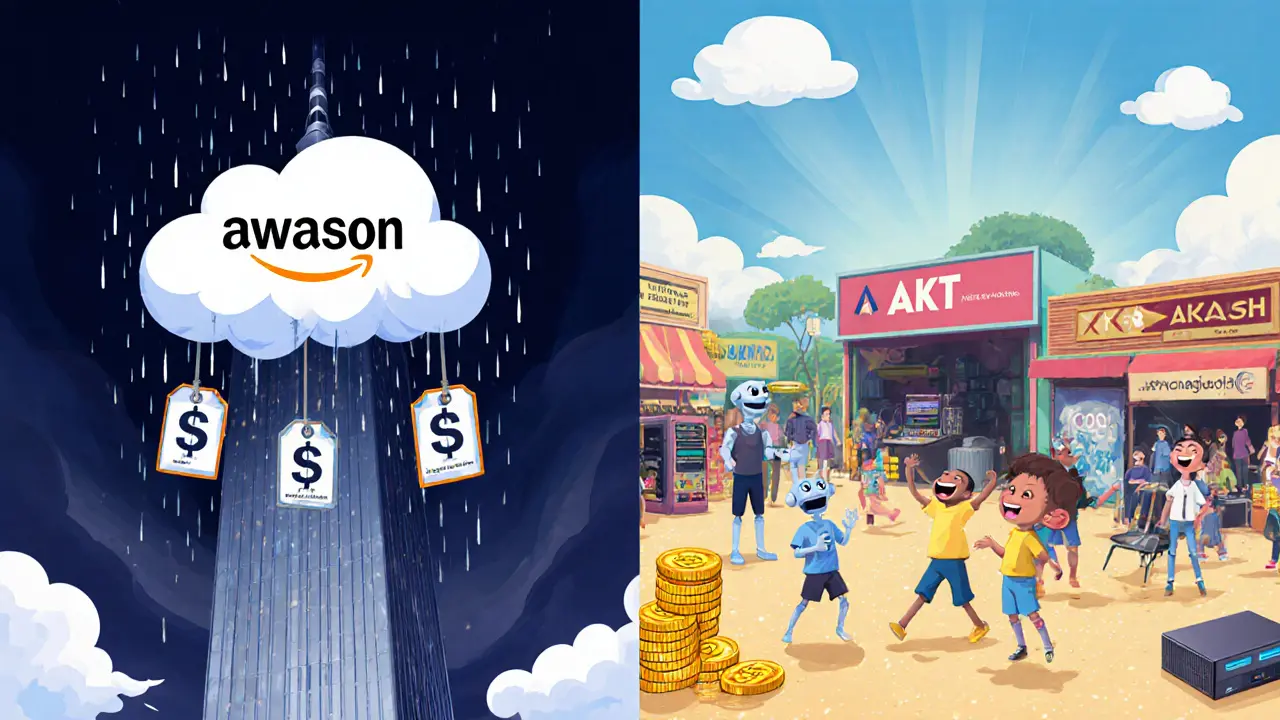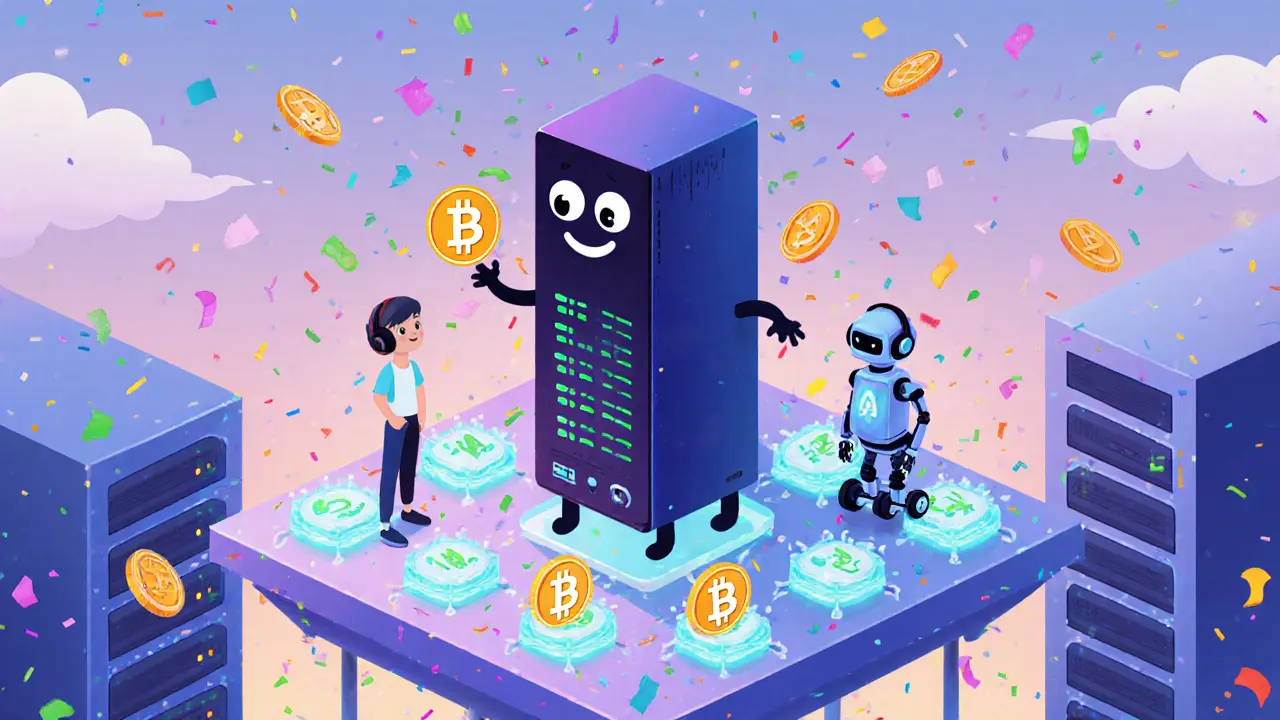Akash Network Cost Comparison Calculator
Compare Cloud Computing Costs
Akash Network isn’t another meme coin or speculative token. It’s a real-world solution to a massive problem: how expensive and centralized cloud computing has become. While companies like Amazon Web Services and Google Cloud charge thousands for server time, Akash lets anyone rent out unused computing power - and buy it cheaply - using blockchain. The native token, AKT, keeps the whole system running. If you’ve ever wondered how AI startups can afford GPUs without breaking the bank, Akash might be the answer.
What Exactly Is Akash Network?
Akash Network is a decentralized marketplace for cloud computing. Think of it like Airbnb for servers. Instead of paying big tech firms for cloud resources, you can rent idle GPU and CPU power from individuals and small data centers around the world. The network uses blockchain to match buyers with sellers, handle payments, and enforce contracts - all without a middleman.
It’s built on the Cosmos blockchain, which means it’s fast, secure, and can talk to other blockchains. It uses the Tendermint consensus mechanism and the Cosmos SDK to make everything work smoothly. Unlike traditional cloud providers, Akash doesn’t own any servers. It just connects people who have extra computing power with people who need it.
This isn’t theory. Real users are already deploying AI models, running video renders, and hosting websites on Akash - often paying 50% to 70% less than AWS or Google Cloud.
What Is AKT, and Why Does It Matter?
AKT is the fuel of Akash Network. Every time someone rents a server, pays for storage, or deploys an app, they use AKT. It’s not just a currency - it’s the backbone of the entire system.
Here’s how AKT works in three key ways:
- Payment: Buyers use AKT to pay for computing resources. But here’s the twist - you can also pay with Bitcoin (BTC), Ethereum (ETH), or other tokens. Akash locks in the exchange rate at the start of the lease, so no one gets surprised by price swings.
- Staking: To help secure the network, users stake AKT. Validators - people who run nodes and verify transactions - must lock up AKT to participate. In return, they earn rewards. Annual staking yields range from 15% to 25%, depending on how long you lock your tokens.
- Governance: AKT holders vote on changes to the network. Want to add support for a new type of GPU? Or adjust the inflation rate? You need AKT to weigh in.
This triple role - payment, security, and voting - is what makes AKT more valuable than most tokens that only do one thing.
How Does Akash Compare to AWS, Google Cloud, or Render Network?
Let’s cut through the noise. Akash doesn’t try to beat AWS at everything. It goes after a specific gap: affordable, decentralized GPU power for AI, machine learning, and rendering.
Here’s how it stacks up:
| Feature | Akash Network | AWS / Google Cloud | Render Network (RNDR) |
|---|---|---|---|
| Cost per GPU hour | $0.01-$0.05 | $0.30-$1.50+ | $0.08-$0.15 |
| Deployment speed | 10x faster than traditional | Minutes to hours | Similar to Akash |
| Centralized? | No - fully decentralized | Yes - owned by big tech | No - decentralized |
| Payment options | AKT, BTC, ETH, stablecoins | Credit cards only | RNDR token only |
| Staking rewards | 15-25% annually | Not applicable | Yes, but lower |
| Use case focus | AI, ML, rendering, general compute | All cloud services | Primarily 3D rendering |
AKT’s biggest edge? You’re not locked into one provider. If prices spike on Akash, you can switch to another seller instantly. On AWS, you’re stuck with their rates.
Render Network (RNDR) is Akash’s closest rival, but Akash supports more than just graphics. It handles databases, AI training, web hosting - anything that needs computing power. That makes it more versatile.

How Is AKT Supplied and Distributed?
Akash launched in September 2020 with 100 million AKT in circulation. Today, there are about 280 million AKT in the wild, with a maximum supply capped at 388.5 million.
Here’s how the original supply was split:
- 34.5% - Investors and early backers
- 27% - Team and advisors (vested over 3 years)
- 19.7% - Decentralized Cloud Foundation (funds development)
- 18.8% - Ecosystem growth, testnets, vendors, marketing
Unlike some tokens that dump all supply at launch, Akash uses a slow, controlled release. Team tokens are locked up for a year, then released gradually. This reduces the risk of sudden sell-offs.
There’s also an inflation mechanism. Around 289 million AKT will be minted over time and given to stakers. But here’s the smart part: the inflation rate drops every day. It’s designed to slow down over time - halving every 2-4 years. That means early adopters get more rewards, but the system stays sustainable long-term.
Who Uses Akash Network?
You don’t need to be a tech expert to use Akash. Two main groups are already on the platform:
- Consumers: AI researchers, indie developers, small startups, and even students. They use Akash to train models, run simulations, or host apps without paying $500/month for AWS. Some use Akash Apps - free tools that let you deploy AI models with one click, no setup needed.
- Providers: People with spare GPUs or data centers. Maybe you bought a gaming PC for crypto mining and now it’s idle. Or you run a small server farm. You can rent out that power on Akash and earn AKT.
Companies like TRG Capital, Alpha Block Investments, and ChainLayer have backed Akash, signaling institutional interest. It’s not just a hobbyist project - real money is betting on it.

What’s Next for Akash Network?
Akash isn’t standing still. The roadmap includes:
- Adding support for more payment tokens - including stablecoins like USDC and DAI
- Launching a Public Goods Fund to reward developers building new tools on Akash
- Improving the user interface so even non-tech users can rent servers easily
- Expanding to support more types of workloads, like blockchain nodes and scientific computing
The goal? Become the go-to platform for decentralized compute - especially for AI. The global decentralized cloud market is expected to hit $800 billion by 2025. Akash is positioning itself to capture a big slice.
Is AKT a Good Investment?
Here’s the truth: AKT is volatile. In October 2024, it dropped over 30% in a month. It’s ranked #183 in market cap - not top 100. That means it’s not as liquid or widely held as Bitcoin or Ethereum.
But look deeper. The fundamentals are strong:
- Real product with real users
- Clear cost advantage over AWS
- Staking rewards that pay you just for holding
- Backed by serious investors
- Part of the fast-growing Cosmos ecosystem
Analysts from Changelly predict AKT could reach $1 by end of 2025 and $7-$9 by 2030. Those are long-term guesses, not guarantees. But if Akash grows to capture even 1% of the decentralized cloud market, AKT’s value could rise sharply.
It’s not a get-rich-quick coin. It’s a bet on the future of cloud computing.
How to Get Started with AKT
If you want to try Akash:
- Buy AKT on exchanges like Kraken, KuCoin, or Gate.io.
- Stake AKT through a wallet like Keplr or Cosmostation to earn rewards.
- Use Akash to rent a server: visit akash.network, connect your wallet, and deploy a compute package.
- Provide computing power if you have spare GPU/CPU - you can earn AKT just by sharing what you already own.
There’s no minimum. You can start with just $10 worth of AKT.
Is Akash Network safe to use?
Yes. Akash uses the Cosmos blockchain, which is battle-tested and secure. Smart contracts are open-source and audited. Payments are encrypted and verified on-chain. The network has never been hacked. As with any crypto project, always use a trusted wallet and never share your private keys.
Can I mine AKT?
No. Akash uses Proof-of-Stake, not mining. You can’t mine AKT. Instead, you earn it by staking - locking your AKT tokens to help secure the network and earning rewards in return.
How do I earn AKT by providing computing power?
Install the Akash provider software on your machine - it’s free and open-source. Connect your GPU or CPU, and the network will automatically match you with buyers. You get paid in AKT for every hour of compute you provide. Many users earn hundreds of dollars a month just by using idle hardware.
What’s the difference between AKT and other crypto tokens?
Most crypto tokens are either currency (like Bitcoin) or speculative assets. AKT is a utility token with real-world use: it pays for cloud services, secures the network, and lets holders vote on changes. Its value comes from actual demand - not just speculation.
Can I use AKT to pay for AWS or Google Cloud?
No. AKT only works on the Akash Network. But that’s the point - Akash lets you avoid AWS and Google Cloud entirely. You get the same services (servers, GPUs, storage) for a fraction of the cost, without being locked into one company.
If you’re tired of paying $500 a month for cloud hosting, or if you’ve got spare GPU power sitting idle, Akash Network is one of the few crypto projects that actually solves a real problem. AKT isn’t just a token - it’s the key to a new kind of internet infrastructure. And that’s worth paying attention to.

Joy Whitenburg
November 13, 2025 AT 00:32Phil Bradley
November 14, 2025 AT 04:09Stephanie Platis
November 15, 2025 AT 20:49Michelle Elizabeth
November 16, 2025 AT 18:20Kylie Stavinoha
November 17, 2025 AT 14:52Diana Dodu
November 19, 2025 AT 07:10Raymond Day
November 20, 2025 AT 13:31Noriko Yashiro
November 20, 2025 AT 20:15Atheeth Akash
November 21, 2025 AT 20:13James Ragin
November 23, 2025 AT 15:55Michael Brooks
November 23, 2025 AT 18:05David Billesbach
November 25, 2025 AT 06:49Andy Purvis
November 25, 2025 AT 13:14FRANCIS JOHNSON
November 26, 2025 AT 05:47Arthur Coddington
November 26, 2025 AT 20:01